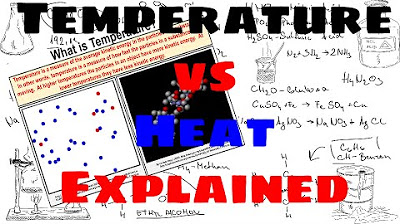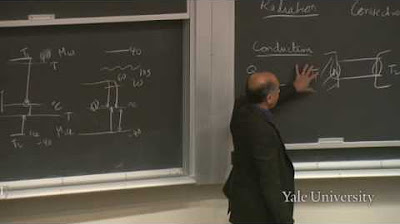Thermal Equlibrium
TLDRIn this AP Physics essentials video, Mr. Andersen explains the concept of thermal equilibrium, where two objects at different temperatures connected will eventually equalize to the same temperature. He uses the example of a computer's graphics processor and CPU, which generate heat and are cooled by a heat sync and fan. The video illustrates how thermal energy transfers from the hotter to the colder object, influenced by mass and temperature, and guided by the conservation of momentum. Through simulations, viewers see how different materials interact thermally, leading to equilibrium. The explanation extends from macroscopic observations to microscopic insights, showing molecular collisions and energy transfers that result in uniform temperature.
Takeaways
- 🔄 Thermal equilibrium is the state where two connected objects with different temperatures eventually reach the same temperature.
- ⚙️ In a computer, the graphics processor and CPU generate heat, which can be mitigated by using a heat sync and a fan to dissipate the heat.
- 🔥 Thermal energy transfer occurs from the hotter object to the colder one until thermal equilibrium is achieved.
- 📏 The amount of thermal energy transferred depends on the mass and temperature difference between the objects.
- 💥 The process of thermal equilibrium is based on the conservation of momentum, where faster molecules collide with slower ones, transferring energy.
- 🧩 In a simulation, placing an iron object on a brick with the same temperature does not change their temperatures, demonstrating no energy transfer.
- 🌡️ Heating the iron and placing it on the brick results in a temperature decrease in the iron and an increase in the brick until they reach equilibrium.
- 💧 Similarly, heating the iron and placing it in water causes the iron's temperature to decrease and the water's to increase until they equalize.
- ❄️ Cooling the iron by placing it on ice transfers thermal energy to the ice, causing the water temperature to decrease and the iron's to increase.
- 🔬 Microscopically, connecting two objects with different temperatures results in the faster molecules transferring momentum to the slower ones, leading to uniform molecular motion and temperature.
- 🤔 The video script encourages viewers to understand and explain the process of achieving thermal equilibrium at both macroscopic and microscopic levels.
Q & A
What is thermal equilibrium?
-Thermal equilibrium is a state where two or more objects in contact with each other eventually reach the same temperature, with thermal energy transferring from the hotter object to the colder one until they are at the same temperature.
Why do computer components like the CPU and GPU generate heat?
-Computer components like the CPU and GPU generate heat because they perform calculations that require energy, which is released as heat.
What is a heat sync and how does it help in managing heat in computers?
-A heat sync is a cooler object used in computers to dissipate heat. It is connected to heat-generating components like the CPU and GPU, transferring heat away from them, often with the help of a fan to blow the heat away.
How does the mass of an object affect the transfer of thermal energy?
-The mass of an object affects the transfer of thermal energy because a more massive object at a higher temperature will transfer more energy than a less massive object at a lower temperature.
What principle does the transfer of thermal energy rely on?
-The transfer of thermal energy relies on the principle of conservation of momentum, where the faster-moving molecules from the hotter object transfer momentum to the slower-moving molecules of the colder object during collisions.
Can you provide an example of how thermal equilibrium is achieved in the script?
-An example in the script is when an iron object is heated and then placed on a brick. The thermal energy from the hotter iron is transferred to the cooler brick until both objects reach the same temperature, achieving thermal equilibrium.
What happens to the temperature of the iron when it is placed on the brick in the simulation?
-When the heated iron is placed on the brick, its temperature decreases as thermal energy is transferred to the brick, until thermal equilibrium is reached and both objects have the same temperature.
How does the script explain the microscopic view of thermal equilibrium?
-The script explains the microscopic view by showing that when two objects with different temperatures are connected, the faster-moving molecules of the hotter object collide with the slower-moving molecules of the cooler object, transferring momentum and eventually leading to the same molecular motion or temperature.
What is the direction of thermal energy transfer according to the script?
-According to the script, thermal energy always transfers from the hotter object to the colder object until they reach the same temperature.
What does the script suggest about the relationship between molecular speed and temperature?
-The script suggests that there is a direct relationship between molecular speed and temperature, with molecules moving faster and having higher kinetic energy in objects with higher temperatures.
How does the script illustrate the concept of thermal equilibrium using water and ice?
-The script illustrates the concept by heating an iron object and then placing it into water. The thermal energy from the hot iron decreases its temperature while increasing the temperature of the water until they reach the same temperature. Conversely, cooling the iron increases its temperature while decreasing the water's temperature until thermal equilibrium is achieved.
Outlines
🔥 Thermal Equilibrium and Heat Transfer
Mr. Andersen introduces the concept of thermal equilibrium, explaining that when two objects at different temperatures are connected, they will eventually reach the same temperature. He uses the example of a computer's CPU and graphics processor generating heat, which is managed by a heat sync and fan to prevent damage. The process involves the transfer of thermal energy from the hotter to the colder object, which is related to the mass and temperature of the objects. A simulation demonstrates this concept, showing that when an iron object is heated and placed on a brick, the temperature of both eventually equalizes. The conservation of momentum is highlighted as the reason for this temperature equalization, as faster molecules collide with slower ones, transferring energy until all reach the same temperature.
Mindmap
Keywords
💡Thermal Equilibrium
💡Heat Sync
💡Thermal Energy
💡Momentum
💡Kinetic Energy
💡Temperature
💡Macroscopic
💡Microscopic
💡Molecules
💡Conservation of Momentum
💡Simulation
Highlights
Thermal equilibrium is achieved when two objects connected together reach the same temperature.
Heat is generated by computer components like the graphics processor and CPU, which can damage the computer if not managed.
Heat syncs are used to transfer heat away from heat-generating components to prevent damage.
Fans are often used in conjunction with heat syncs to dissipate heat more effectively.
Thermal energy transfer occurs from a higher temperature object to a lower temperature object until thermal equilibrium is reached.
The amount of thermal energy transferred depends on the mass and temperature of the objects involved.
Momentum conservation plays a role in the transfer of thermal energy between objects.
Molecules in warmer objects move faster and transfer momentum to slower-moving molecules in cooler objects.
A simulation demonstrates that objects at the same temperature do not undergo temperature change when connected.
Heating an iron object and placing it on a brick shows the transfer of thermal energy from the iron to the brick.
Thermal equilibrium is achieved when the iron and brick reach the same temperature.
Adding thermal energy to water by heating an iron object results in a temperature decrease for the iron and an increase for the water.
The conservation of momentum ensures that thermal equilibrium is eventually achieved between the iron and water.
Cooling an object involves the transfer of thermal energy from the warmer object to a cooler one, such as ice.
Microscopic examination shows that molecules in higher temperature objects have higher kinetic energy and move faster.
Connecting two objects of different temperatures leads to molecular collisions and the transfer of momentum.
The process of achieving thermal equilibrium involves both macroscopic and microscopic perspectives.
The video aims to help viewers understand the principles of thermal equilibrium at both macroscopic and microscopic levels.
Transcripts
5.0 / 5 (0 votes)
Thanks for rating:





